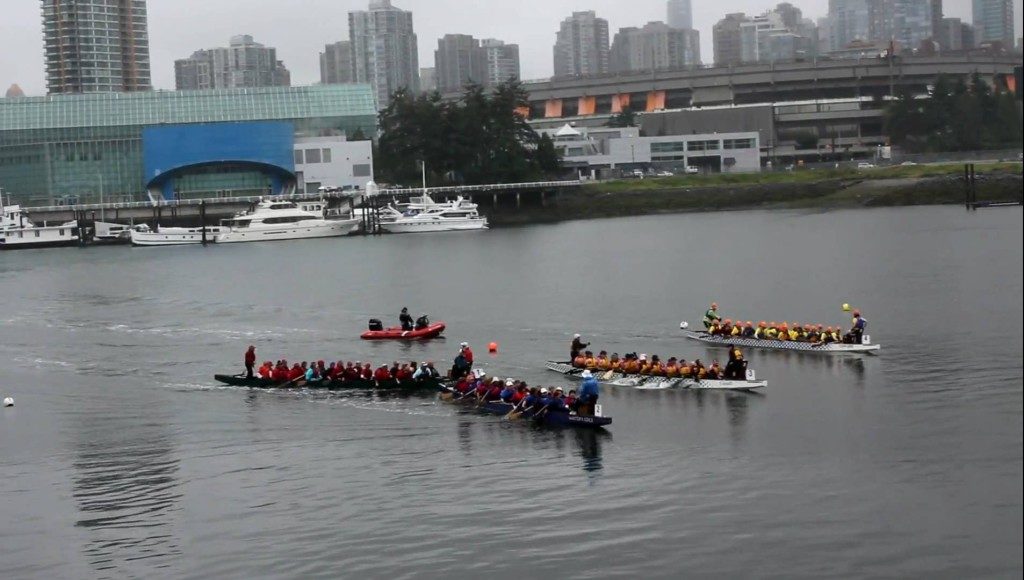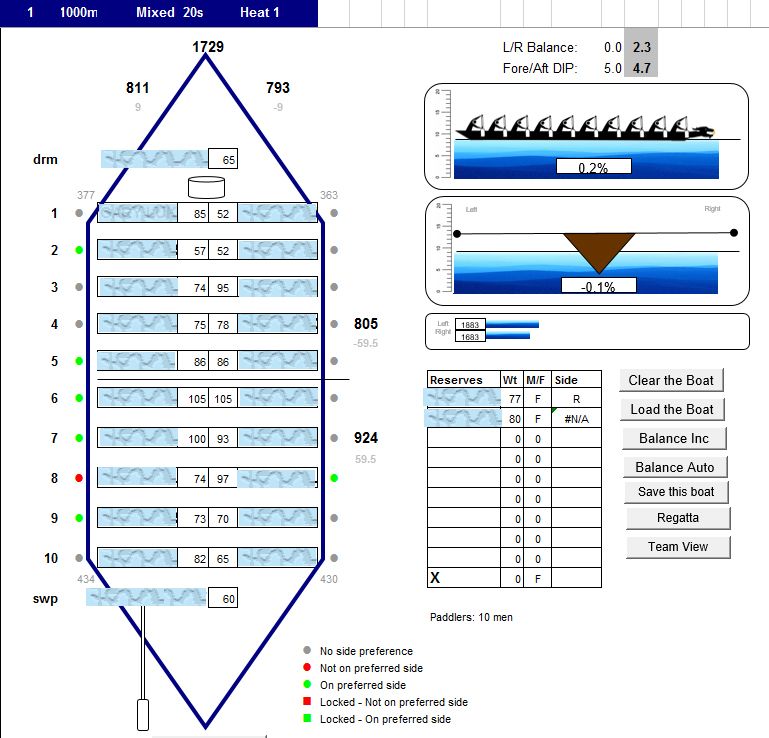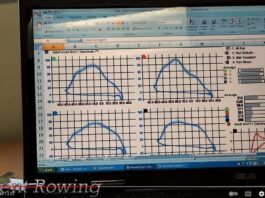Why are you losing? Your team trains hard but in races you seem to be ploughing through the water. Or dragging the back end of the boat.
Your sweep is constantly making corrections – each time slowing the boat down. The boat is low on one side. All of these symptoms could be related to one issue – an unbalanced dragon boat.
A balanced dragon boat makes for a safer dragon boat. An easier to steer dragon boat. A faster dragon boat.
With a balanced boat the sweep (or steersman) does not have to make so many corrections. Less corrections means less additional drag from their sweep oar. Faster boat.
If your boat is balanced, both left & right and front & back, then it will glide through the water as it was designed to do. Faster boat.
This post will show you how to balance a dragon boat. Firstly the way everyone else does it. Then my (right?) way.
How to balance your boat the conventional way.
Front half weighs the same as the back half. Left weighs the same as right.
Recreational teams partner up paddlers with someone who is more or less the same weight. This will result in an approximation of a left-right balanced boat. But it is not accurate.
Competitive teams balance their boat by making the total of the left weights balance the right. And the total of the front weights balance the back. Often they have spreadsheets that will automatically add up the weights – front, back, left and right. That way coaches can know immediately if one side is heavier than the other.
Sounds logical, right? Balanced weights equals a balanced boat. Right?
I am about to show you something interesting.
Here is a screenshot of a dragon boat balancing spreadsheet using the conventional method. I have deliberately made it (look) back heavy.

If you are happy to use this method, I have provided an online freemium version of the spread sheet here.
If you are curious to learn the new way – read on.
How to balance your boat the Dragon Analytics way
My philosophy when loading a boat is a little different, OK – a lot different – to many others.
Remember back when you were a kid and your dad (or someone heavier than you) would sit close to the fulcrum on a see-saw so that his weight would balance yours? The weight on one side is heavier than on the other but it balances! Hmmm.
I treat my dragon boats as more like a see-saw. I apply the Principle of Moments.
I record the weight of my paddlers AND take note of what bench they sit on. Because it matters.
For example, an 80kg paddler in bench 10 puts more downward pressure on the back of the boat than the same 80kg paddler in bench 6. Yet they are both in the back half.
An 80kg paddler in bench 6 could be balanced by a 65kg paddler in bench 1.
What? The boat is balanced even though the back half weighs MORE than the front half? The answer is “Yes”.

The back half can weigh more than the front half and yet the boat can be balanced.
To stack a balanced dragon boat my way, treat the boat as a see-saw, pivoting around the middle of the boat.
Here is how I would stack a balanced Dragon Boat.
Rank the paddlers by an assortment of metrics including technique, ergo results, timing, etc. The best paddlers are given priority when loading the boat.
Get paddlers’ accurate weights (strangely, the hardest part).
If required, determine the paddlers’ locations in the boat. That is, stroke, or engine room, or near the front, or near the back. I usually determine this from my observations of each paddler and how they interact with other paddlers in the boat. For example: Put those with a tendency to shorten up away from or behind longer reach paddlers.
Then I determine if I want my boat balanced, or slightly front heavy. Front heavy?? Yes, front heavy. There are some teams experimenting with loading front heavy boats. I will be writing a post on this soon.
When all of that data is locked in, I do one of two things.
Load the boat with my best paddlers, on their preferred side, in their area of the boat. Be mindful of what bench they are in so that the “see-saw effect” is accounted for and the boat remains balanced.
Swap paddlers from left to right, forward and back until the boat is balanced. As you can imagine, this can be quite time consuming.
OR
I click “Load the Boat” followed by “Balance the Boat”. Yes, my fine Dragon Boat friends – I have created my own program to do all of this for me. See the screen shot below (names have been removed to protect the not so innocent).
Notice that:
- Although the back half is heavier than the front half, the boat is in fact slightly front heavy!
- Everyone (except 1 paddler) who has a preferred side, is on it.
- The sweep can counteract the fact that the boat is slightly left heavy.
Balanced boats every time, in record time.
Paddlers to get the best return on their efforts, and the sweeps to have a dream run as the boats now track beautifully through the water.
It also allows the option to quickly re-stack the boat on race day if someone pulls out and a reserve with a different weight jumps in.
How much difference does a balanced boat give you in a race? I haven’t tested that yet but it has to be better than an unbalanced boat and even if it is one tenth of a second. How many races have YOU lost by one tenth of a second? Me? Too many!!
This program will be available to you online soon but in the meantime if you would like me to produce a balanced boat for you, download this spreadsheet, fill it in and send it to me.
PS: The Freemium version alluded to earlier in this post includes my balance engine in the spreadsheet.
You will see Fore/Aft Balance and Fore/Aft DIP numbers. The first is the conventional way of matching weights. The second is my way using the Principle of Moments (think see-saw).
The formula is modeled on the Champion Boat. I cannot guarantee perfect accuracy if you have a different boat.
Play with the sample data and see if you can generate a balanced boat even if the weights don’t balance.
















Love this post!!
I love this article! Very great.
Is the program available now?
Hi
Thanks for your reply. The program is not available yet. I am going to make it available as a free service online. Stay tuned…..
An older post as I commented 2 years ago 🙂. Let me guess, load the boat front heavy and the bow cuts through the water better than a back heavy boat which plows like tug boat ?? 🙂 Due to the narrower portion of the bow touching water first vs the wider areas further back?
Stern squat. When a boat is pushed close to its “maximum hull speed” the stern will squat down into the water.
Hi Gordon,
I have carried some on water trials since the original post but I have yet to get any significant data supporting the loading of the front. Although the tests weren’t at race speeds. But I haven’t given up yet..
Looking from under the water, the hull will take on one of three forms – Fish form, symmetrical and Swede form. Swede form kayaks tend to cruise at slightly faster speeds. Loading a dragon boat nose heavy will tend to give the boat a swede form shape under water. Could this result in speed improvements? (Post to follow)
This boat was well loaded, it is useful to get your homework first. This photo is taken from a team at Theems GRR. And the waves were about and half feet. Great helming art, and a team who knows what it is
Good teamwork, great team!
I’ve been waiting for the ‘full’ version….thanks! It seems that different makes of boats handle slightly differently. We paddle both Champions and Buk and there is a slight but noticeable difference between them…could have something to do with the position of the sweep/helm perhaps. Whatever…get it right and it feels and handles well….get it wrong….urgh!
Geoff Roberts. Yes different boats perform ,well ,differently. Even different models of Champion. What I hope to instil in coaches is measure, measure, measure. It’s the only way to find the real answers.
I am more than willing to post coach’s findings.
I asked Champion and they recommended slightly back heavy for their boats. Hope this helps.
Great post!! Thanks!! I’m part of a female team in Argentina and your post will help us a lot to improve and save time defining positions on the boat.
Thanks!!! (and if you have the excel, please send it to us chilldragonpuertos@gmail.com )
;o)
Hi
Thanks for your response and I hope your team is having a great season. I will post you the latest (simplified) version of the spreadsheet. It is currently set up for a Champion 20s boat but I hope to have a more versatile version out soon.
Regards
Mark
Hi Mark,
I handle the dragon boating team for a University in Dubai. Our team keeps changing constantly and having a system where we can modify the seating arrangements will be extremely helpful. Please let me know where i can find the latest version of the spreadsheet or please email me at ybps2002@gmail.com.
Thanks!
Best Regards
Sid
Hi Sid,
The spreadsheet has evolved (devolved?) to something that is simpler, faster and more organic. Most coaches knows their balancing strategy so I have tweaked the tool to be more agile. No macros required. Just type in the paddlers number’and the formulas will show you the balance. I have emailed you the latest version with some sample data. It is for a 20s boat (10 seats) and I am working on one for the smaller 10 seaters.
Cheers
Mark
Hi Mark,
Love this post and the use of the see-saw concept to balance a boat. I’m keen to use your spreadsheet too for a 10s boat if it is ready. My email address is bagel_mindy@hotmail.com. Thank you.
Hi Vei Li Soo, Coming soon.
Hi Mark, excited to hear that you’ve updated the spreadsheet. Would it be possible to get a copy?
All the best,
Barry
bobrien6626@gmailcom
Hi Barry, Coming soon
Hi Mark, I would love a copy of that spreadsheet you mentioned in the previous comment please. Thank you so much for the work you’ve put in here! dustinbromley@gmail.com
Hi Dustin, Coming soon
Hi Mark,
Wonderful work and explanations. Please let me know when we can have a copy of the spreadsheet.
Thank you
Hi Mark, excellent post. Would it be possible to get a copy of the updated spreadsheet?
Thank you kindly
James
jamesjmcgrath@outlook.com
Hi James
Thanks for the comment.
I am currently tweaking the sheet to allow for both 10 and 20s boats. Once complete, I will release it.
Cheers
Mark
Great post and website. Love the analytics of it all. Would it be possible to get a copy of the spreadsheet? Alexanderchan54@gmail.com
Hi Alex
Thank you for your comment. The spreadsheet will be available soon.
It will be provided as a part of Silver membership (which is not available yet, but stay tuned)
Regards
Mark
Hi Alex,
I am the coach of the first Dragon boat team for breast cancer survivors and all-cancer survivors in Costa Rica. I am very interested your balancing spreadsheet for a 10-person dragon boat.
Kind regards,
Mrs. Toby Bothel
dragonboatcr@gmail.com
Whats app: +1-301-448-2803.
Hi Toby
Thanks for your email. I am currently updating the website and adding a section for tools such as the dragon boat balancing spreadsheet.
Stay tuned for the new additions.
Regards
Mark
I am a coach for a rec team that is doing more festivals and this post was a great read. I would love to have this spread sheet to help be set up the boat for success.
Hi Bonnie
Thanks for your email. I am currently updating the website and adding a section for tools such as the dragon boat balancing spreadsheet.
Stay tuned for the new additions.
Regards
Mark
Hi Mark,
Great helpful advice.
Please could you kindly send me your latest copy of the spreadsheet?
Please email:
Shadwelldragons@gmail.com
Thank you in advance!
All the best,
Amin
Hi Amin
Thanks for your email. I am currently updating the website and adding a section for tools such as the dragon boat balancing spreadsheet.
Stay tuned for the new additions.
Regards
Mark